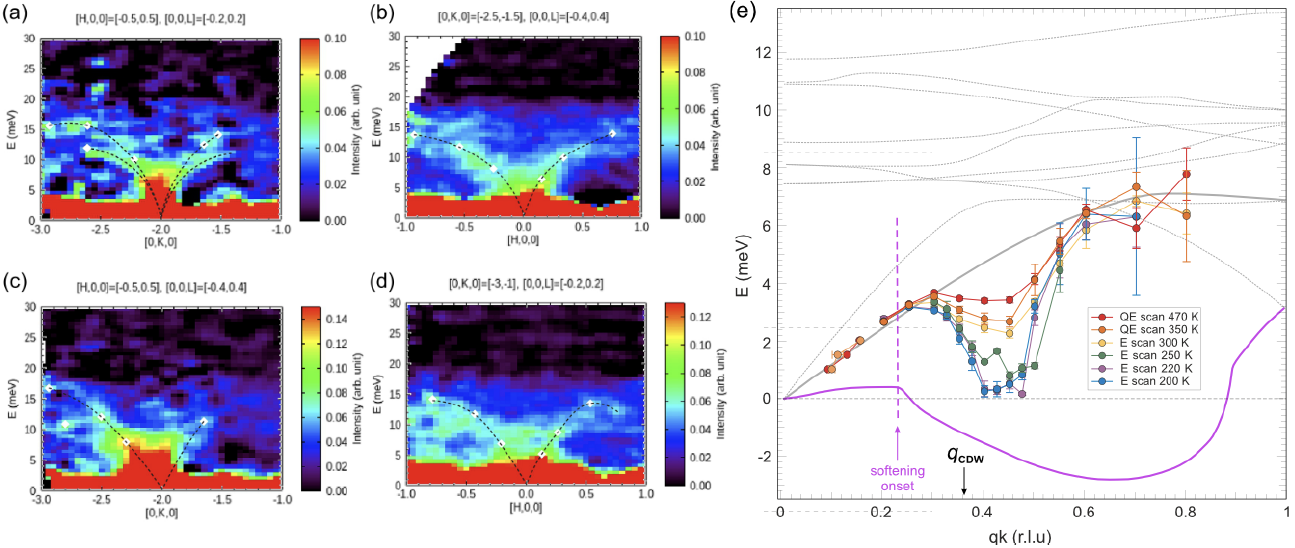◆ 研究成果
Q-dependent electron-phonon coupling induced phonon softening and non- conventional critical behavior in the CDW superconductor LaPt2Si2
Symmetry-breaking phenomena underpin various intriguing physical properties in condensed matter, such as magnetism [1,2,3,4] and superconductivity (SC) [5,6,7]. In particular, the interplay between incommensurate charge ordering phenomena (charge density wave-CDW) and SC is believed to be a key factor in understanding the mechanism behind non-conventional SC, which is one of the major unresolved questions in modern condensed matter physics.
The quasi-2D Pt-based rare earth intermetallic material LaPt2Si2 represents an ideal study case in this framework as it exhibits strong interplay between CDW and SC. This material was found to host two CDW transitions, occurring at two different temperatures (T1 = 230 K, T2 = 110 K), accompanied by as many structural and superstructural transitions [5].
In this work [6], by means of triple axis (TAS) and time of flight (TOF) inelastic neutron scattering, we were able to directly observe a phonon softening instability, being already in place at a temperature as high as 470 K, leading to the full collapse of the phonon branch in correspondence with the CDW transition at T1. From this observation we were able to deduce the nature of the CDW transitions in LaPt2Si2. In particular, a 2-dimensional character and a strong q-dependence of the electron-phonon coupling as a driving mechanism is proposed for the CDW transition at T1 = 230 K. For the second CDW transition at T2 = 110 K, we suggest a 3-dimensional character and Fermi surface quasi-nesting as a driving mechanism. The two CDWs are related, being the q-vector of the T2 transition a multiple of the q-vector of the T1 transition, and should propagate separately in the non-equivalent Pt2 and Pt1 layers. A non-conventional critical behavior for the temperature dependence of the phonon collapse, together with the presence of multiple q-vectors, structural instabilities, and intensity fluctuations of the superstructural Bragg satellites induced by the charge modulations, indicate discommensuration of the CDW in this material. Finally, broad linewidths of the phonon dispersion curves in the full temperature range suggest the presence of high- temperature phonon scattering and an anharmonic character of the vibrational modes in LaPt2Si2.
This work is published in J SCI-ADV MATER DEV [6]. The TOF neutron inelastic scattering experiment was performed at the spectrometer HRC under the J-PARC user program (Proposal No. 2019B0421).

Figure 1: a-d) Overview of the phonon modes for the Bragg point (0 -2 0) at 85 K (a,b) and 220 K (c,d) showing broad linewidths. Data taken by TOF-INS. e) Phonon dispersion curves for the Bragg point (2 0 0) at different temperatures showing the collapse of the phonon branch. Data taken by TAS-INS. Figure adapted from ref. [6]
[1] E. Nocerino et al., Sci. Rep. 12, 21657 (2022).
[2] E. Nocerino et al., J. Phys.: Conf. Ser. 2462, 012037 (2023).
[3] E. Nocerino et al., J. Phys. Mater. 6 035009 (2023).
[4] E. Nocerino et al., Commun. Mater. 4, 81 (2023).
[5] E. Nocerino et al., Commun. Mater. 4, 77 (2023).
[6] E. Nocerino et al., J Sci-Adv Mater Dev 8, 4 100621 (2023).
[7] E. Nocerino, Doctoral dissertation, Kungliga Tekniska högskolan (2022).
◆ 論文等
◆ 論文等